In Australian Aboriginal mythology, Mamaragan or Namarrkon is a lightning Ancestral Being who speaks with thunder as his voice. He rides a storm-cloud and throws lightning bolts to humans and trees. He lives in a puddle.

Kakadu National Park is a protected area in the Northern Territory of Australia, 171 km (106 mi) southeast of Darwin. It is a World Heritage Site. Kakadu is also gazetted as a locality, covering the same area as the national park, with 313 people recorded living there in the 2016 Australian census.
Major Leslie James Hiddins AM, known as "The Bush Tucker Man" is a retired Australian Army soldier and war veteran who is best known for his love and knowledge of the Australian bush. Hiddins is recognized by his distinctively modified Akubra hat and big cheesy grin.

The wandering whistling duck is a species of whistling duck. They inhabit tropical and subtropical Australia, the Philippines, Borneo, Indonesia, Papua New Guinea and the Pacific Islands.
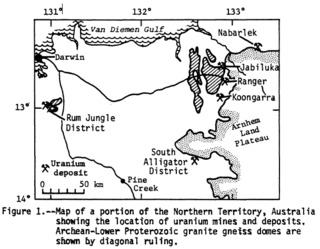
Alligator Rivers is the name of an area in an Arnhem Land region of the Northern Territory of Australia, containing three rivers, the East, West, and South Alligator Rivers. It is regarded as one of the richest biological regions in Australia, with part of the region in the Kakadu National Park. It is an Important Bird Area (IBA), lying to the east of the Adelaide and Mary River Floodplains IBA. It also contains mineral deposits, especially uranium, and the Ranger Uranium Mine is located there. The area is also rich in Australian Aboriginal art, with 1500 sites. The Kakadu National Park is one of the few World Heritage sites on the list because of both its natural and human heritage values. They were explored by Lieutenant Phillip Parker King in 1820, who named them in the mistaken belief that the crocodiles in the estuaries were alligators.

Bush tucker, also called bush food, is any food native to Australia and used as sustenance by Indigenous Australians, the Aboriginal and Torres Strait Islander peoples, but it can also describe any native flora or fauna used for culinary or medicinal purposes, regardless of the continent or culture. Animal native foods include kangaroo, emu, witchetty grubs and crocodile, and plant foods include fruits such as quandong, kutjera, spices such as lemon myrtle and vegetables such as warrigal greens and various native yams.

Gunbalanya is an Aboriginal Australian town in west Arnhem Land in the Northern Territory of Australia, about 300 kilometres (190 mi) east of Darwin. The main language spoken in the community is Kunwinjku. At the 2021 Australian census, Gunbalanya had a population of 1,177.
Bininj Kunwok is an Australian Aboriginal language which includes six dialects: Kunwinjku, Kuninjku, Kundjeyhmi, Manyallaluk Mayali (Mayali), Kundedjnjenghmi, and two varieties of Kune. Kunwinjku is the dominant dialect, and also sometimes used to refer to the group. The spellings Bininj Gun-wok and Bininj Kun-Wok have also been used in the past, however Bininj Kunwok is the current standard orthography.
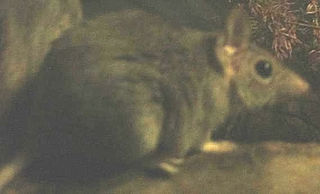
The fawn antechinus is a species of small carnivorous marsupial found in northern Australia. It is the only Antechinus to be found in the Northern Territory and has a patchy, restricted range.
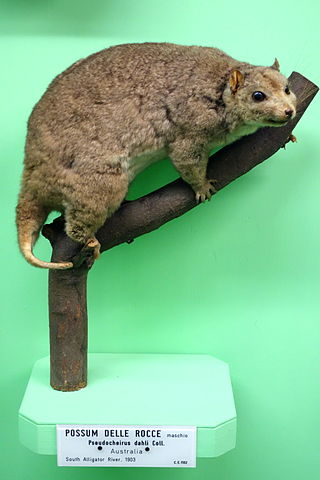
The rock-haunting ringtail possum, also known as the rock ringtail possum, is a species of Australian possum. It is found in rocky escarpments in the Kimberley, Arnhem Land and Gulf of Carpentaria across Western Australia and Northern Territory and just passing the Queensland border. It is also found on Groote Eylandt. It is the only species in the genus Petropseudes, but is part of the group including the common ringtail possum.
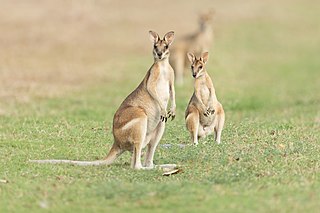
The agile wallaby, also known as the sandy wallaby, is a species of wallaby found in northern Australia and southern New Guinea. It is the most common wallaby in north Australia. The agile wallaby is a sandy colour, becoming paler below. It is sometimes solitary and at other times sociable and grazes on grasses and other plants. The agile wallaby is not considered threatened.

The Jim Jim Falls is a plunge waterfall on the Jim Jim Creek that descends over the Arnhem Land escarpment within the UNESCO World Heritage–listed Kakadu National Park in the Northern Territory of Australia. The Jim Jim Falls area is registered on the Australian National Heritage List.
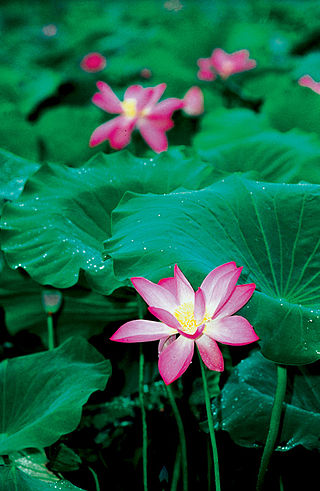
This is a list of plants commonly found in Kakadu National Park, Northern Territory of Australia. Where known, common names are given in English and in Gun-djeihmi, a commonly spoken indigenous language in the area, are given in parentheses.
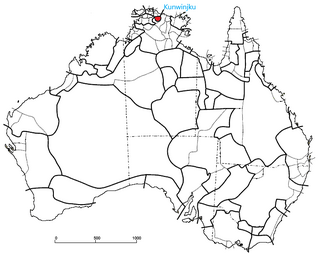
The Kunwinjku people are an Australian Aboriginal people, one of several groups within the Bininj people, who live around West Arnhem Land to the east of Darwin, Northern Territory. Kunwinjku people generally refer to themselves as "Bininj" in much the same way that Yolŋu people refer to themselves as "Yolŋu".

Persoonia falcata, commonly known as the wild pear, is a shrub native to northern Australia.

Sersalisia sericea, also known as wild prune, mangarr, and mongo is a species of shrubs or small trees, of the plant family Sapotaceae They grow naturally in monsoon forest, littoral rainforest, and occasionally in more open forest types across Northern Australia.

Livistona humilis, the sand palm, is an Australian plant species of the family Arecaceae. It is a small, slender palm, growing to about 7 m tall and 5–8 cm dbh. It has 8 to 15 fan-shaped leaves, 30–50 cm long with petioles 40–70 cm long. It is endemic to the Top End of the Northern Territory in Australia. Genetic investigation suggests that its closest relation is Livistona inermis. This palm is fire tolerant and usually grows in environments where it is exposed to frequent fires.
The Bininj are an Aboriginal Australian people of Western Arnhem land in the Northern Territory. The sub-groups of Bininj are sometimes referred to by the various language dialects spoken in the region, that is, the group of dialects known as Bininj Kunwok; so the people may be named the Kunwinjku, Kuninjku, Kundjeyhmi (Gundjeihmi), Manyallaluk Mayali, Kundedjnjenghmi and Kune groups.
Terminalia canescens, commonly known as joolal, winged nut tree, or wingnut, and also known by its Aboriginal name djilanydjin in north-western Australia, is a tree of the family Combretaceae native to northern parts of Australia.
Terminalia cunninghamii, commonly known as pindan quondong, pindan walnut or kalumburu almond, is a tree or shrub of the family Combretaceae native to Western Australia. Some Aboriginal people know the plant as kumpaja.















